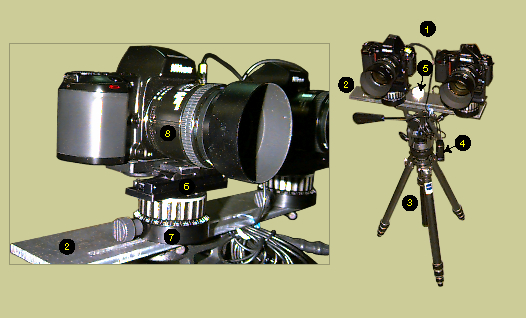
Closets: | A | B | C | d | E | F |
Greetings! You were asking about my stereo setup. Here is a brief description of my system. Everyone who gets into stereo photography needs to work up their own system based on available equipment and personal needs. You may not be able to exactly duplicate this setup, but if you understand the principles of stereo, you can make a workable system of your own.

1. Two matching camera bodies: Nikon N8008s
2. A slide bar: Custom built. Allows for lateral repositioning of cameras. I also have a four foot bar.
3. Sturdy tripod: Gitzo. Model # G1372.
4. Electronic shutter-release cable: custom modified to send signal to both cameras simultaneously.
5. Bubble level for orienting cameras to horizontal alignment.
6. Two camera brackets for quickly flopping between vertical and horizontal formats. I do not know the maker of these brackets. Here is a closer view of one, attached to a rotating tripod head, and set to the vertical format. Perhaps using this image can help research the maker.
7. Two Bogen rotating and locking tripod heads, used here to adjust toe-in of cameras.
8. Two matching lenses -- cannot be zooms. While 50 mm lenses are overall best for stereo, 85 mm lenses are ideal for figure, portrait, and sometimes landscape. More telephoto power might be problematic.
This is a stereo slide viewer (lamp above it). The white thing attached to the left side of the viewer is a plastic reflector which bounces light into the back which holds a frosted glass window (not in view here). The two cylinders contain high quality optical lenses. Two separate 35 mm slides, taken as a stereo pair, are inserted into the body of this viewer and, by means of light transmitted through the back frosted glass window, are viewed together through the lenses with your two eyes.
Cost: Thousands of dollars. I spent just over $4,000 to get my setup, including the viewer's armature and storage bags, when much of this equipment was only available new. Perhaps people following in my footsteps can save a couple thousand by careful shopping for used equipment. There are many ways to assemble a stereo setup, once you know the specs. Please fully inform yourself of your own requirements by studying the principles of stereo photography before taking the plunge.
The (Combi) viewer came from:Hugo De Wijs
Specialist in stereoscopic photography and manufacturer of 3-D equipment, since 1955.
http://www.dewijs-3d.com
3-D information and product resources
Reference
The World of 3-D, A practical Guide to Stereo Photography
by Jac. G. Ferwerda
Published by 3-D Book Productions, Borger, The Netherlands
ISBN 90-71377-51-2
Links to 3D Dealers & Resources
http://stereoscopy.com/reel3d
Closets: | A | B | C | d | E | F |
Also in the Idea Library:Explanatory Comments
Museum Notes
Proposals